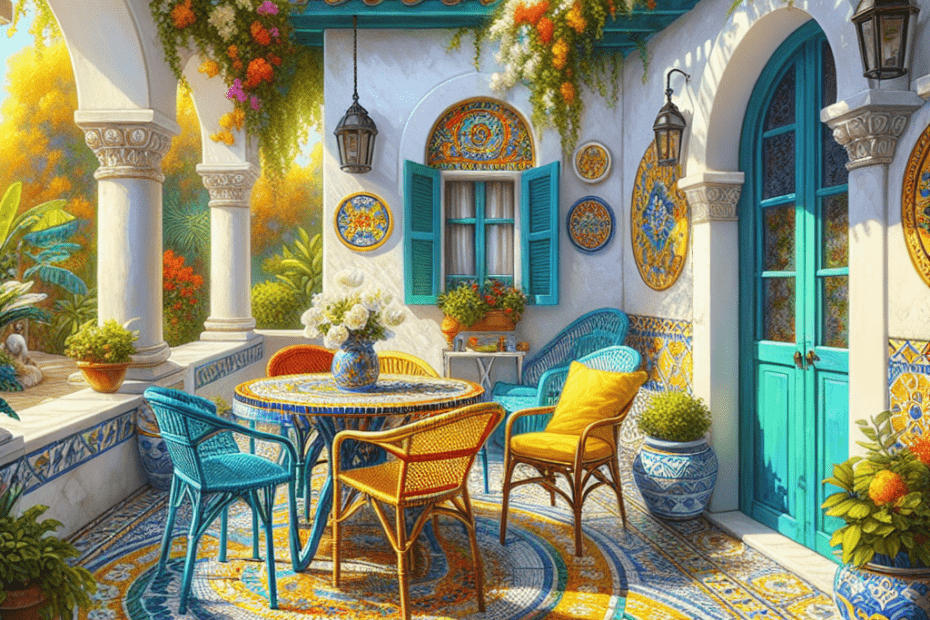“`html
Exploring the Role of Bright Colors in Mediterranean Design
When one imagines a Mediterranean-style home, images of bright blues, sunny yellows, and warm terracotta shades might come to mind. Across countries like Greece, Italy, and Spain, bright colors play a crucial role in Mediterranean design, making spaces feel lively, warm, and inviting. This design aesthetic reflects the sun-soaked coasts and lively, energetic cultures found in these regions. Through the creative use of color, Mediterranean design evokes feelings of relaxation and joy. With more homeowners seeking to infuse their spaces with these lively hues, understanding their role and impact can help in crafting cozy and aesthetically pleasing environments.
The Essence of Bright Colors in Mediterranean Design
Mediterranean design is all about capturing the essence of coastal living. At the heart of this aesthetic lies the use of vivid and varied colors. Whether it’s a splash of cerulean blue reminiscent of the sea, a burst of orange reflecting the evening sunset, or a rich green symbolizing lush olive groves, these colors bring a slice of the Mediterranean into the home. According to a survey by Color Marketing Group, 65% of Mediterranean-style interiors are characterized by the use of bright, bold colors contrasted with neutral tones.
Elements Enhanced by Bright Colors
The defining feature of the Mediterranean design is its harmonious blend of nature and architecture, where bright colors play a pivotal role in several key elements:
| Design Element | Color Impact |
|---|---|
| Walls | Bright walls reflect sunlight, giving rooms a clean, airy feel. |
| Floors | Terracotta tiles in rich browns and reds ground the space and add warmth. |
| Decors | Vivid ceramics and textiles provide vibrant accents. |
| Furniture | Painted in deep blues and greens, furniture pieces become focal points. |
By carefully selecting colors, homeowners can highlight architectural features and infuse personality into their spaces.
The Psychology Behind the Colors
Color psychology plays a significant role in Mediterranean design. Bright colors are known to evoke emotions and set moods. For instance, blue is calming and helps reduce stress, while yellow stimulates optimism and creativity. These effects align with the relaxed yet vibrant lifestyle of the Mediterranean region. According to a study by the University of Sussex, warm colors like red and yellow can increase energy levels and emotional warmth by up to 12%. This can transform interiors into spaces that feel as if they are basking in perpetual sunlight.
Global Appeal and Adaptation
The attraction of bright colors extends well beyond Mediterranean shores. In the United States, for example, home designs inspired by the Mediterranean have seen a rise in popularity. Home improvement platforms like Houzz have reported a 30% increase in searches for Mediterranean-inspired decor in the last five years. This design preference offers a combination of aesthetic appeal and the sense of a dreamy getaway without leaving home.
Modern Interpretations of Mediterranean Design
Though traditional Mediterranean design relies heavily on bold, natural colors, contemporary interpretations have emerged. Designers are experimenting with combining classic Mediterranean colors with modern elements such as minimalist furniture or sleek, industrial materials. This fusion maintains the vibrancy of the Mediterranean while updating it for modern tastes. The Pantone Color Institute notes that many Mediterranean palettes are embracing a broader spectrum of hues, incorporating pastel versions of traditional colors to update and freshen the look while maintaining the original warmth and charm.
Key Takeaways
- Mediterranean design is characterized by bright, bold colors that reflect the sun-soaked coasts and energetic culture of the region.
- Bright colors in walls, floors, decor, and furniture play a pivotal role in creating the Mediterranean aesthetic.
- There’s a strong psychological element as colors like blue and yellow are used to evoke calmness and optimism.
- Mediterranean design has seen a global rise in popularity, showing appeal beyond its origin.
- Modern adaptations of this design include incorporating minimalist and industrial elements while retaining the vibrant color palette.
FAQ
- What are the most common bright colors used in Mediterranean design?
Common colors include blues, yellows, terra cotta, and greens that reflect the natural surroundings of the Mediterranean.
- How do bright colors enhance the Mediterranean design style?
They add warmth, reflect sunlight, and emphasize architectural elements, creating a lively and inviting space.
- Can this style be adopted in any location?
Yes, Mediterranean design can be adapted globally, allowing homeowners everywhere to enjoy its warm and vibrant aesthetic.
- How do bright colors affect mood in interior spaces?
Bright colors like blue and yellow can reduce stress, increase energy, and stimulate feelings of happiness and relaxation.
- What modern trends are influencing Mediterranean design today?
Contemporary Mediterranean design incorporates pastel hues, minimalist furniture, and industrial features while maintaining traditional color warmth.
“`
In this article, readers can appreciate how bright colors play an integral role in shaping Mediterranean design and understand why this vibrant approach is celebrated worldwide. The blend of tradition and modernism ensures its lasting impact on interior design trends.
